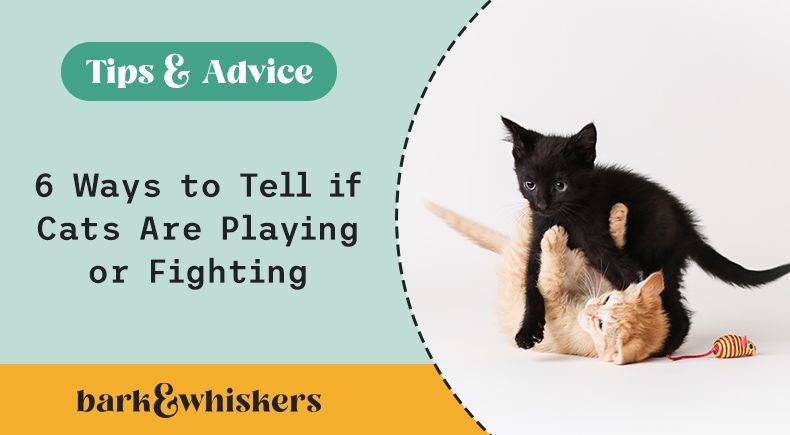6 Ways to Tell if Cats Are Playing or Fighting
If you share your home with multiple cats, you may sometimes wonder if their interactions are friendly or aggressive - or a mixture of both.

STORY AT-A-GLANCE
- A recently published study sheds some much-needed light on cat-cat interactions, specifically play behavior that has the potential to escalate to fighting
- The researchers used several tools to collect and categorize feline behaviors into six categories, including wrestling, chasing, and vocalizing
- Next, they separated their observations of 210 cats into three groups of interaction types: playful, agonistic (aggressive), and intermediate (a blend of the first two)
- Results showed that most (56%) of the cats fell into the playful group, with 29% falling into the agonistic group, and the remaining 15% in the intermediate group
- Important takeaways from the study: A pair of wrestling cats are likely playing; cats who are vocalizing and chasing each other are probably fighting; vocalizing, chasing, resting cats may be sizing up the situation and deciding whether to continue, or stop
Because the behavior of domestic cats is, shall we say, a wee bit more difficult to interpret than that of most dogs, the feline species presents a wide-open field for scientific research into what makes the little darlings tick.
Toward that end, a team of researchers from Slovakia and the U.K. set out to investigate the differences between play behaviors among cats and play-like behaviors that have the potential to turn into fights. Their study, published recently in Scientific Reports,1 suggests that cats often participate in a mixture of playful and aggressive behaviors that may escalate into fights if the owner doesn’t assume the role of referee.
How the Study Was Conducted
The goal of the research team was “to use simple behaviors anyone could observe to work out what was play and what might lead to fights. This is important because the consequences of fights include injuries to animals and humans. At worst, you may even have to rehome one of your cats if they’re not getting along.”2
First, lead study author Noema Gajdoš-Kmecová from the University of Veterinary Medicine and Pharmacy in Slovakia and the University of Lincoln, U.K. and colleagues viewed about one-third of 105 videos of interactions between 210 cats. They sourced the videos from YouTube and directly from cat owners using search terms like “cats play fighting,” “cats play with each other,” “cats playing together,” and “cats fighting”:
Cat friends Tom and Mimi play fighting
Buddies Davis and Parker playing like male cats
Cat fight: Tom and Mimi vs. a neighborhood stray
Next, the researchers developed an ethogram (a record of behaviors performed by an animal used in ethology, which is the scientific and objective study of animal behavior)3 based on their initial observations of the cats. They used the ethogram to assemble behaviors into six observable categories as listed below, which they then used to assess the rest of the cats in the videos:
- Inactive — head and body motionless and in specific position, for example, crouching
- Wrestling — cats in physical contact, with wrestling movements
- Chasing — one cat runs in pursuit, or another cat runs away
- Other interactive activities — for example, grooming, approaching, raised fur on back
- Non-interactive — activity directed towards themselves or an inanimate object, for example, drinking, self-licking
- Vocalization — for example, growling, hissing, meowing
Most of the Cats in the Study Fell into One Group
The kitties were separated into groups based on the frequency and duration of the six behaviors. Meanwhile, four of the researchers watched the same videos and created three groups of interactions between cats:4
- Playful (friendly interactions) — 56% (118 cats, who primarily wrestled, and didn’t vocalize)
- Agonistic (aggressive interactions) — 29% (60 cats, who demonstrated behaviors including threatening, aggression, and submission; they also vocalized and had recurring periods of inactivity)
- Intermediate (a mixture of both playful and aggressive interactions) — 15% (32 cats, who behaved more like the playful vs. the agonistic group; they interacted for prolonged periods with pauses in between)
When the research team compared the six behavior groups with the three interaction groups, they discovered that wrestling behavior between cats was predominant in the playful group, while the agonistic group spent the most time vocalizing and chasing each other.
The intermediate group displayed characteristics of both groups but was closer overall to the playful group than the agonistic group. They displayed prolonged periods of behaviors such as laying on their back (belly up), pouncing, stalking, and approaching and grooming each other. The researchers theorize that this combination of playful and aggressive behaviors may indicate a short-term disagreement between cats and not a breakdown in the relationship.
They suggest that if owners can identify potential tension between cats in the same household, they can better manage the relationship, preventing an escalation of aggressiveness and the need to rehome feline family members.
Take-home message: When we’re able to interpret cat behavior, we can relax and give them the freedom to frolic with friends and avoid potential enemies.5
- If cats are quietly wrestling, it’s likely they’re playing
- If they’re vocalizing and chasing each other, it’s likely they’re fighting
- If they’re vocalizing, chasing, and resting, it’s likely they’re sizing up the situation and deciding whether to continue, or stop
Sources and References
Today's Pet Video:
You Can't Help but Love This Cat!
Lilith, their rescue kitty, has a big personality. She’s demanding and knows what she wants. Like when they take the dogs for a walk and she swats the dogs when they come back in!











